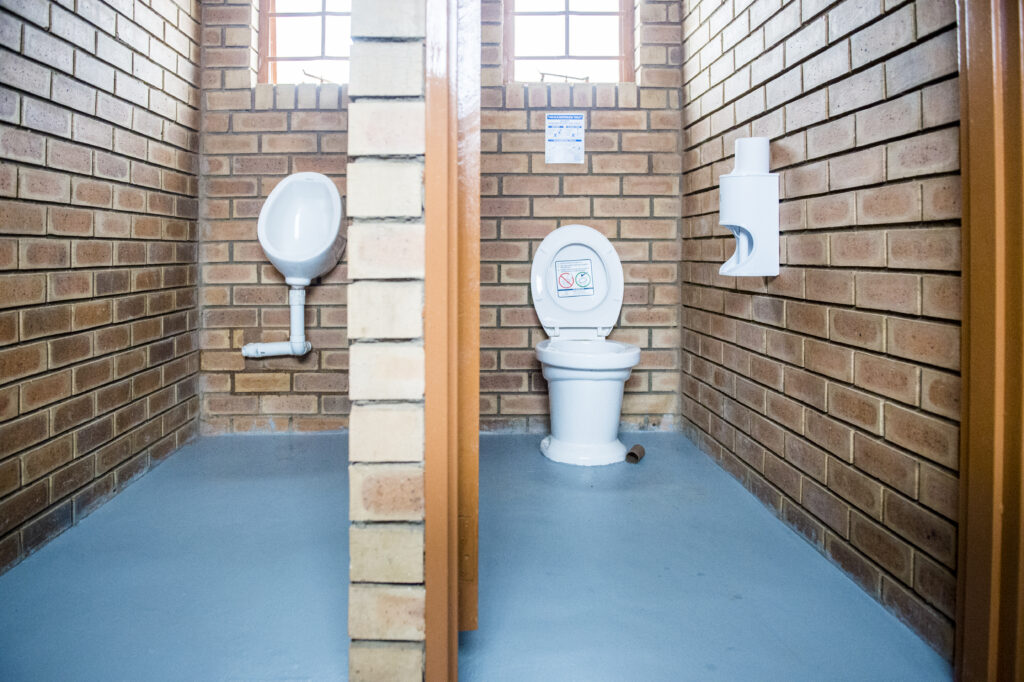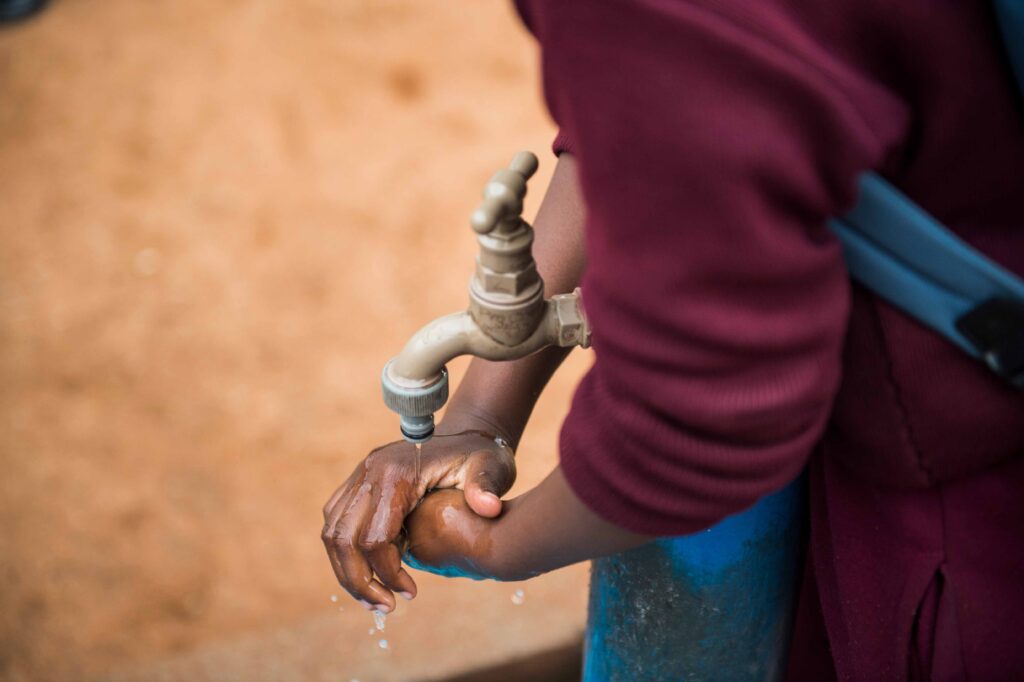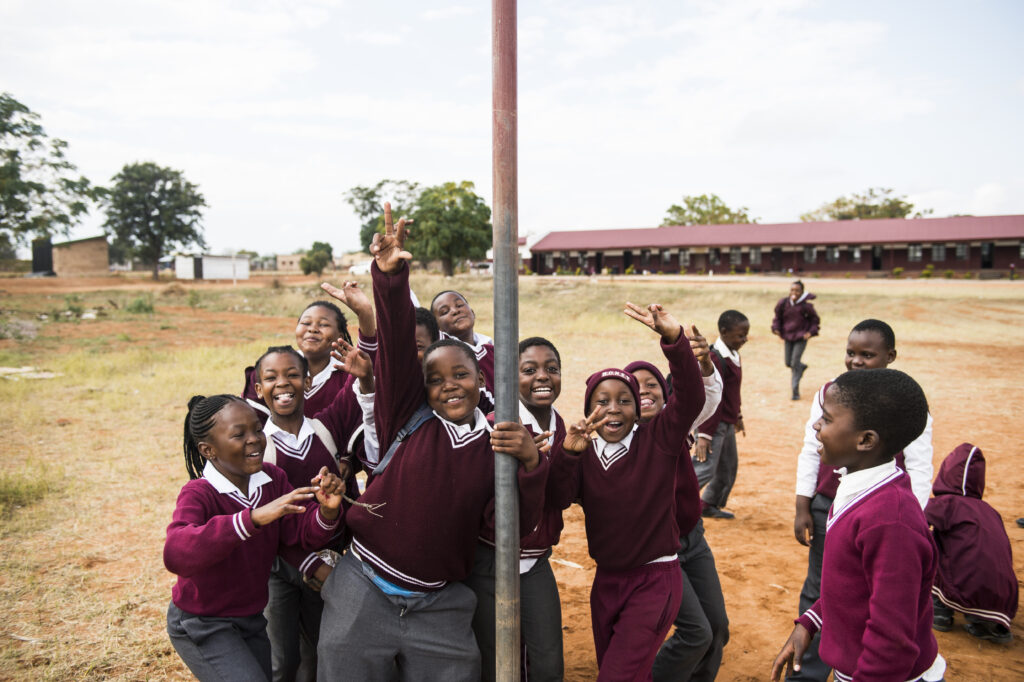- By January, learners at 210 schools in Limpopo still had to use pit toilets. Although it’s down 153 from a year before, progress is happening at an inconsistent pace.
- By the end of March, the department had already missed their first deadline in the court-ordered plan to fix schools’ sanitation, which makes their hitting the 2028 goal for getting rid of all pit toilets seem unlikely.
- However, India managed to increase the number of toilets in rural areas from 39% to 95% in just five years. Can Limpopo learn from them?
Phillip Mansokoana holds open the broken door of a dilapidated cubicle made of corrugated iron, rusted at the hinges from standing out in the open. It’s a few hundred metres from the main school building. Next to it are five more like it.
“GIRL” or “BOY” is painted in big, pink and blue letters on the doors — hiding nothing but a low plastic platform built up around a hole in the ground, with a toilet seat fixed on top.
Standing aired and dry now, four months ago, these were still the toilets for the 258 learners of the Soka Leholo Primary School in Ga-Makgato, a small rural village about halfway between Polokwane and Louis Trichardt in Limpopo.
Mansokoana, the deputy principal of the school, says learners had been waiting for flush toilets since 2015. It took the provincial education department almost eight years to deliver, following new rules added to the Schools Act in 2013 that said pit toilets are not allowed at schools any longer.
Despite the new facilities now being in place, the abandoned pit structures remain on the school premises. There are 2 333 other schools just like Soka Leholo in the province. If left like this, they’re a hazard that could result in someone’s death — as what happened to five-year-old Michael Komape, who drowned when he fell into a pit toilet at his school in 2014.

There’s no way staff can keep the kids safe from the old toilets, even now that there’s no reason for them to use the facilities anymore.
Says Peter Mailula, chairperson of the school’s governing body: “The best we can do is to wire the doors shut.”
The good
Although slow, there does seem to be progress though.
According to the latest provincial data on Section27’s Michael Komape Progress Monitor, by January, 210 of 3 761 schools still had only pit toilets, down from 363 in December 2021, when Limpopo’s education department submitted its plan for getting rid of pit toilets to the Polokwane High Court.
This means that about 6% of schools have only pit latrines, compared with about one in four schools in 2018 according to government data.
[WATCH] Health Beat #10 | What SA’s dirty water does to your health
But the nonprofit Equal Education, which in advocating for kids’ quality schooling has taken the department to court about sanitation before, is sceptical of these numbers as “education departments, particularly those in rural provinces [like Limpopo’s] are known for giving unreliable and inconsistent data”, says Tiny Lebelo, one of the organisation’s campaigners who contributed to a 2022 report on toilet facilities at the province’s schools.
Without accurate data, she says, “departments are likely not planning properly [for getting rid of pit toilets] because they often don’t have a clear picture of the actual need”.
In response to Bhekisisa’s questions about whether data quality has improved, spokesperson for the province’s education department, Mike Maringa, simply replied: “Yes, we have made progress.”
The bad
Clean, working toilets and water for handwashing are about more than having a wee. It’s part of children’s right to good education, says the United Nations (UN).
Without these facilities, children can miss school days when they get sick with runny tummies or other diseases that spread through contact with dirty hands, such as airway infections, or if girls don’t have dignified spaces for menstruation days.
If poor sanitation services cause children to drop out of school, their chances at better economic development are blocked, because they struggle to get good jobs and don’t become active citizens in their societies.
The 2013 rules about school buildings ban plain pit latrines. Instead schools should have “a sufficient number of toilets for learners and teachers”, which must be clean, safe and private, and be in a working state.

According to the 2022 update to Section27’s handbook on basic education rights, the government wanted this done by no later than 2020.
Yet despite this policy, there are still schools where there are either nothing but pit toilets or where these loos have not been demolished after proper facilities were built, and education departments, both at national and provincial level, have missed almost all of their infrastructure deadlines.
At the moment, the Limpopo department of education is more than 125 days behind its planned schedule for fixing schools’ sanitation facilities. Moreover, data shows that between 2015 and 2021, the pace at which toilets were being demolished was inconsistent — 298 were eradicated by 2020, less than a third the next year, and in 2022, only 32.
At this rate, there’s no way to know when schools will be free of pit toilets.
When the department submitted their plan to break down and replace pit toilets to the court in 2021, they estimated that the goal would only be met by 2031 because of a limited budget. Judge Gerrit Muller slammed this timeframe as “unreasonable”, agreeing with the plaintiffs’ argument that 14 years “provides cold comfort” to children who, over the course of their 12-year school career, would not have the dignity of using a flush toilet. The deadline was therefore revised to 2028.
But according to Lebelo the delays are not only about there not being enough money for the changes, as the department alleges. Blame should also go to a lack of political will, poor project planning and not spending the budgeted money, she says.
Passing the buck might be part of the problem, too. In 2022, the education department told parliament that one of the main reasons for the delay in clearing the sanitation backlog is the poor performance of “service providers” or “implementing agents”.

These implementing agents, such as the Development Bank of Southern Africa and the Mvula Trust, assign orders for toilets to contractors.
But, says Lebelo, because good monitoring systems are not in place, and progress reports and expenditure statements are not publicly available, it’s difficult to track how service providers are doing.
Maringa told Bhekisisa that they’d received an adequate budget for this financial year, but that he was not aware of the challenges around implementing agents.
Better is possible
Giving everyone access to a proper toilet is slow-going. According to the World Health Organisation and Unicef, worldwide 642-million children didn’t have basic sanitation at their school in 2015. By 2021, this number had dropped to 539-million — a change of only 103-million in six years.
As things stand now, only Australia, New Zealand, North America and Asia will be able to provide proper loos for all by 2030 — the deadline for the UN’s Sustainable Development Agenda.
Poorer regions, such as sub-Saharan Africa, will likely give only about eight out of 10 children access to good sanitation by then, leaving 310 million-children worldwide without toilets.
But India’s Clean India Mission is an exception — and has set an example for policies in other developing countries such as Nigeria and Ethiopia.
In just five years, between 2014 and 2019, the country managed to up the number of toilets in rural areas from 39% to 95%. Celebrities, athletes, religious leaders and the prime minister put their weight behind the project. Because of this, lots of public funds were poured into getting things going, and service providers were trained and held accountable for delivering.

One of the main aims was to change public attitudes toward sanitation by making it “everyone’s business”. This included a special tax for the project and all ministries — including the health and education departments — had to make the project part of their annual plans.
This ensured schools and healthcare facilities had enough toilets.
In Ga-Makgato, school sanitation is indeed “everyone’s business”. Residents volunteer to keep the new Soka Leholo toilets clean, which Mansokoana says instilled a new sense of pride in the community.
Says Mansokoana: “The children were so happy with the new toilets. One said, ‘I’m never using a pit toilet ever again!’”
Christina Pitt is a health journalist at Bhekisisa.





